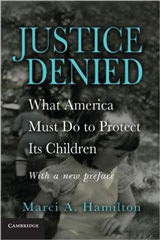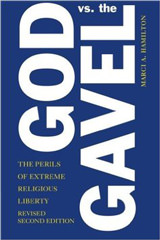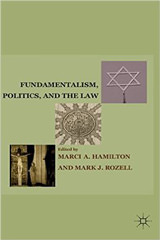It did not take long after Justice Antonin Scalia’s unexpected passing for someone to attack him for having authored Employment Div. v. Smith, and to accuse him of “abandoning” religious liberty. It is an unfair charge and those who take this line need to check their facts. Equally misguided is the hysteria following his passing that religious liberty will be unprotected without him on the Supreme Court.
Let’s consider some facts.
As I document in God vs. the Gavel: The Perils of Extreme Religious Liberty, this article, and on behalf of Rep. Bobby Scott in an amicus brief filed in the Zubik v. Burwell case pending at the Supreme Court, the Court’s ruling in Smith (that a drug counselor could be denied unemployment compensation for using an illegal drug, even if it was used at a religious service) was an accurate recounting of the Court’s First Amendment cases. I was clerking for Justice Sandra Day O’Connor at the Court that year, later had access to many of the justices’ papers on the Smith case, and there is little historical doubt that Smith presented facts rarely seen before.
In the vast majority of free exercise cases, the underlying religious conduct itself was legal behavior. For example, attendance at church on a Saturday; being a pacifist seeking an exemption from serving in combat; or taking care of the elderly on your own as a community. But Smith sounded most like Reynolds v. United States where the believer had violated a criminal law. In Smith, the religiously motivated conduct was using an illegal drug; in Reynolds, it was having more than one wife. The Court did not struggle with the result, as one might have expected if the justices were radically revising the doctrine. Rather, the justices viewed the case as an opportunity to provide needed clarification of existing doctrine.
The Smith majority (not Scalia by himself) described the lynchpin in the system that has made the United States a haven for believers but also a safe place where believers do not have a right to harm others, as it was first stated in Reynolds:
Can a man excuse his practices to the contrary because of his religious belief? To permit this would be to make the professed doctrines of religious belief superior to the law of the land, and in effect to permit every citizen to become a law unto himself. Government could exist only in name under such circumstances.
That vision captures the genius of our First Amendment free exercise protection. The Reynolds Court was correct when it first coined the phrase critical of any “citizen becom[ing] a law unto himself,” and Justice Scalia’s opinion in Smith wisely repeated it.
Those who attacked Smith and Scalia—because he was the author of the majority’s opinion—actually had a different agenda. It’s not that the Court had departed from its usual approach in Smith. Quite to the contrary. They were upset that his opinion had definitively and finally rejected their arguments for extreme protection in previous cases. There had been a push since the 1960s when Justice William Brennan for a majority inserted strict scrutiny into a free exercise case, Sherbert v. Verner. Ever after, religious entities increasingly demanded extreme protection in every free exercise case. The Court again and again rejected their extreme demands, letting neutral and generally applicable laws stand, and then in Smith painted the big picture, explaining that while there is a long history of appropriate, permissive religious accommodation (think of the exemption for communion wine during Prohibition) in American law, history and the First Amendment do not mandate accommodation for a believer from neutral, generally applicable laws. The Court distinguished Sherbert; it also distinguished the indefensible opinion in Wisconsin v. Yoder, which tragically paved the way for religious communities to fail to educate their children, thereby disabling them in an increasingly verbal, online society.
The Coalition for the Free Exercise of Religion aggressively pushed the propaganda that Smith was a “dramatic departure” from prior doctrine in Congress, and persuaded members to enact the Religious Freedom Restoration Act (RFRA), claiming it was a simple “restoration” of prior law. That’s right—they said they were “simply” asking the Court to negate one decision—Smith. They persuaded members of Congress that all they needed to do was to pass RFRA to essentially erase Smith’s effect and the world would right itself. Members of Congress believed that the ACLU, People for the American Way, Americans United for Separation of Church and State and the religious entities banding together in the Coalition must be on the up and up, and took the bait: They enacted RFRA in 1993, which was not the Court’s previous standard but rather the previously rejected standard under the First Amendment.
What Scalia’s majority opinion laid out in Smith was a vision of a democratic system wherein there is law and order, and for those who find their religious liberty impacted by a law that is neutral and generally applicable, they have the right to ask their legislature or other policymakers for exemptions. And do we have exemptions? Thousands. He was secure in the knowledge that religious practices that would not harm others could be accommodated, and would be, but he was also frank in saying that the Court was the wrong branch to carve up neutral, generally applicable laws.
He was so right. What followed Smith? Exemptions wherever the tiny Native American Church needed them! Despite this increase in religious liberty through legislative exemptions, RFRA was enacted regardless, and lo and behold, we have the Court doing what Justice Scalia’s majority opinion in Smith said was beyond its institutional competence: unilaterally choosing which accommodations to carve out of duly enacted, neutral laws.
Alarmingly, RFRA transformed the Court into the vehicle for each person to be a law unto him or herself. That became apparent when the Court’s Burwell v. Hobby Lobby decision led the Court to find that a large, for-profit company could tailor its benefit package according to its owners’ religious beliefs—without regard for employees’ rights not to be discriminated against based on religion or gender in benefit packages. That decision operated at the ethereal level where all women could receive cost-free contraception covered by an endlessly wealthy government, according to the Court, but landed in the reality that the women working for religious believers like the Green family of Hobby Lobby would have to pay for whatever contraception their bosses disapproved for religious reasons until the government proposed a new accommodation. The same religious groups object to this accommodation as well, which is essentially the same as the accommodation that will be considered in Zubik v. Burwell this Term.
True, Scalia signed onto the majority in Hobby Lobby, but not because he abandoned the Smith vision of the Constitution. Rather, according to Justice Samuel Alito’s majority opinion in that case, RFRA invited the justices to become case-by-case policymakers with the sole purpose being to carve out a space for each believer from any inconvenient law. Moreover, the substance of Hobby Lobby—contraception purportedly (but not really) operating as abortafacients—triggered Scalia’s deep, visceral disapproval of abortion. His attacks on Justice O’Connor, and his polemics generally, in the abortion context will not go down in history as his most sterling judicial moments. He unfortunately took the bait that RFRA lays out for all judges, letting himself be persuaded he was competent to act as a super legislature and craft the contraception benefit he would have preferred.
There are plenty of reasons to disagree with Scalia in other arenas, and in fact he loved a good verbal dispute, but history will prove that Smith was the better approach and Scalia, as its author, should be honored and revered for it. Because of Smith, the First Amendment is no refuge for the sex abuse of children by clergy or the medical neglect of children or forced child labor or wife-battering or employment discrimination or Jim Crow-like discrimination in the marketplace. The federal and state RFRAs sadly opened these doors, but as mere statutes they can be discarded as they should be. The Smith decision charts the shining American path between liberty and harm and toward religious diversity without religious tyranny.
Thank you for Smith, Justice Scalia, and may you rest in peace.










Strange. Smith overreached. The existing rule sounded strict but in practice found various loopholes. The new rule sounded too much of a threat to religious liberty. The best path was probably somewhere in between (such as a never written Burger opinion involving driver license photos that turned out to be a 4-4 tie). Instead, we got RFRA, which Prof. Hamilton finds very troubling on constitutional grounds. But, Scalia never provided a warning again after Smith except in the federalism case of Boerne (but RFRA led to baby state RFRAs anyhow).. In fact, a few times Scalia went further than other justices in his demands for free exercise such as in Locke v. Davey. Smith was seemingly an easy call — peyote for Indians, a criminal statute though the court below decided it narrowly and the opinion was an unnecessary moment of judicial activism. The reply was in the end “worse than the disease” in Prof. Hamilton’s eyes. And, Scalia didn’t stick to his convictions. Net: things got worse.